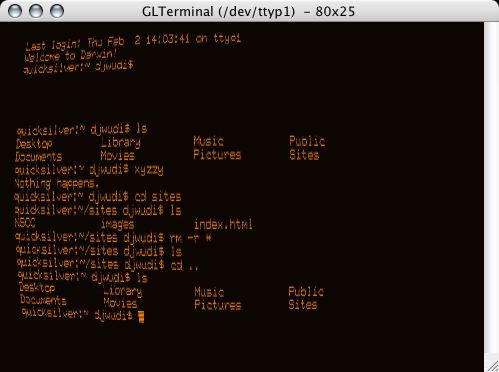Back again, new and improved — after swapping out my old, dead video card with a brand-spankin’ new Radeon 9800 Pro Mac Special Edition video card, my Mac is back up and running. A wee bit noisier than it was before, thanks to the fan on the video card (a simple heat sink isn’t enough for this one, apparently), but the main thing is that it’s up and running.
Of course, because life isn’t easy, even this simple seeming endeavor was not without its fair share of challenges.
The first — and the most nerve wracking — was the task of getting from Northgate to the U District through the combined messes of rush hour and holiday traffic. It had taken Prairie half an hour to get from home to the mall to pick me up after work (a drive that normally takes between three and five minutes) and had decided that that was all she could handle (quite understandably so), so I took over the driving from there. We managed to get to the Mac Store and back home in about an hour, so it wasn’t entirely bad…but it wasn’t entirely fun, either.
Next was getting the card itself. This should have been a simple task, but I inadvertently slightly complicated matters when I misstated the specifications of the card and said that I thought it had 512 Mb of onboard RAM. There were a few moments when I was afraid that we were about to be sucked into a debate between salespeople as to whether any Mac video card came with 512 Mb of RAM, but managed to point out that it really didn’t matter as long as they had a card and I could give them money to walk out with it. Crisis narrowly averted.
Lastly, once home, came the process of actually installing the card. Now, I’ve done such things before on other machines, so I was expecting a rather simple task: pop the case open, pull out the old card, put in the new card, close the case, and go on from there. The first two steps went fine, but then I made a mistake no self-respecting geek should ever admit to.
I read the manual.
I know, I know: who actually reads the manual? Still, at the time, it seemed a good idea. The problem I soon ran into was that according to the manual, the card required a power connection from the computer, something that could be accomplished with the use of a ‘Y’ power connector included with the card. This made sense, as it’s a newer, more powerful video card, except for one thing: there was no power connector in the package. Hmmmmm.
Double- and triple-checking the package commenced, with no power cord mysteriously appearing out of thin air. Rereading the manual multiple times didn’t help either, as the words failed to spontaneously rearrange into a friendly message saying, “oh, nevermind, we just wanted to see if you actually bothered to read the manual, go on ahead without the power cord.”
Pity, that. I’d have been amused at that — annoyed, yes, but amused, too.
I did notice, however, that the manual made repeated references to the card as a “Radeon 9800 Pro Mac Edition”…and my box said that I had a “Radeon 9800 Pro Mac Special Edition”. Hmmmm. Could the ‘special’ part of “special edition” mean that it simply drew power through the connection socket, and didn’t actually need the apparently mythical power cord? It was starting to look that way, especially as the card didn’t appear to even have a plug to attach a power cord to. However, I wanted to be sure.
As there were still fifteen minutes left before the Mac Store closed, I gave them a call, and explained my situation to the person on the other end. A bit befuddled at first, he started checking things out, first via the web, then going into the back to look for a box that he could crack open. He wasn’t able to find a box, but he did find some more information on the web. “What color is the circuit board?” he asked.
“Blue.”
“Ah. Yes — the blue card doesn’t have a power connector.”
I paused for a moment, then laughed. “Well, yes, this much I know,” I said. “I just wanted to make sure that that’s how things are supposed to be!” After a few moments, we came to the conclusion that as the pictures he’d found of the cards showed a red board with a power connector, and a blue board without a power connector, then I was probably fine, and they’d simply put a generic instruction manual in the box.
Sure, this was the same conclusion I’d been coming to on my own — but at least this way, I had confirmation from a second source.
So there we were. I put the card in, closed the case, reconnected everything, hit the power button…
…heard the computer start up…
…saw the lights on the keyboard flash…
…heard the scanner initialize…
…and then, finally, saw the power light on the monitor switch from the blinking amber of its ‘sleep’ state to the bright steady green indicating that it was getting a signal.
Success! Huzza, hooray, calloo, callay! And all was right with the world.
And so now, the old (dead) video card is no more, and the new (working) video card is quite happily (and nosily) humming to itself…and I’m the new owner of more video processing power than I’ll ever need.
I have an 8-pixel pipeline, which doesn’t sound very big at all, but is trumpeted on the box as something important, so I’ll assume that it’s a good thing. There’s 128-bit full floating point precision — an important thing, because sinking points would just pile up all the pixels at the bottom of my screen. I have SMARTSHADER™ for cinematic-quality lighting effects (which, I’m sure, will do wonders with the web pages I visit daily). I have VERSAVISION™ to rotate my display to a portrait orientation (of course, as my monitor doesn’t rotate to a portrait orientation, this will give me quite the crick in my neck — but I can do it!).
And lastly, according to the ATI Displays software, I have the option to “Enable Alternate DVI TMDS Receiver Mode”, which “Enables coherent TMDS Receiver support (Ti receiver).” I don’t even know if that’s English, or any language that might have some relation to English…but it’s an option.
I just might have to find some game to play just to justify having this card at some point, or the card’s likely to get bored with text windows and webpages, tell me to shove off, go on strike, and I’d have to do this whole thing over again.








